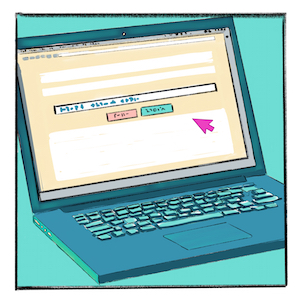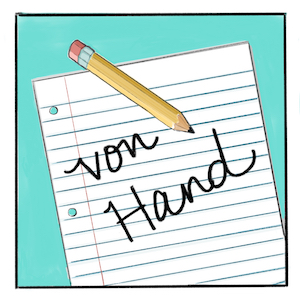In dieser Lektion
Wortschatz
Review the vocabulary from the main lesson!
Strukturen
Pluralformen von Kleidungsstücken
For some additional practice with the singular and plural forms of accessories and articles of clothing, study the vocabulary and then complete the following exercise!
Kultur
Kleidung einkaufen

 Imagine you are traveling to a German-speaking country and your luggage has been lost. Where will you shop for clothing? Do some online research and explore where you might find clothes to fit your budget and personal style.
Imagine you are traveling to a German-speaking country and your luggage has been lost. Where will you shop for clothing? Do some online research and explore where you might find clothes to fit your budget and personal style.
Strukturen
Verben: tragen (to wear)
The irregular verb “tragen” (to wear or to carry) is often referred to as a “vowel-changing verb” because it has a vowel change in the present-tense singular “du” and “sie / er / es” forms, where the vowel “a” becomes “ä” (a with an umlaut above it).
| singular | plural | ||
|---|---|---|---|
| ich | trage | wir | tragen |
| du | trägst | ihr | tragt |
| Sie | tragen | Sie | tragen |
| sie / es / er xier / they | trägt | sie | tragen |
Other vowel-changing verbs that follow the same pattern (a => ä; au => äu) include “schlafen” (to sleep), “waschen” (to wash), and “laufen” (to walk or run).
Verben: sehen (to see)
“Sehen” (to see) is also an irregular verb with a vowel change in the present tense. Like “tragen,” it has a vowel change in the singular “du” and “sie / er / es” forms, but with “sehen” the vowel “e” becomes “ie.”
| singular | plural | ||
|---|---|---|---|
| ich | sehe | wir | sehen |
| du | siehst | ihr | seht |
| Sie | sehen | Sie | sehen |
| sie / es / er xier / they | sieht | sie | sehen |
Another vowel-changing verb that follows the same pattern (e => ie) is “lesen” (to read): ich lese, du liest, sie / es / er liest, wir lesen, usw.
Now for some practice!
Schreiben
Was hängt in Ihrem Kleiderschrank? Was ist in Ihrer Kommode?
 Write a description of what’s hanging in your closet (Kleiderschrank) or stored in your dresser (Kommode). Use plural forms and review your numbers in German to state how many of each clothing article you have.
Write a description of what’s hanging in your closet (Kleiderschrank) or stored in your dresser (Kommode). Use plural forms and review your numbers in German to state how many of each clothing article you have.
Zum Beispiel: In meinem Kleiderschrank habe ich fünf Hosen, sieben Kleider, ….
Was tragen Sie? Was tragen die andere Personen in Ihrer Klasse?
Write sentences about what your classmates are wearing. Use the notes that you may have taken in class. When possible, combine the descriptions, to make them more interesting. Here are an example and some steps to help you.
Modell: Adan, Jakob und Lea tragen T-shirts. Leas T-shirt ist blau, aber Adan und Jakob tragen lila. Adan trägt eine braune Hose, aber blau ist Leas Hose. Jakob trägt Jeans. Adan trägt weiße Sportschuhe, aber Jakob trägt Sandalen. Lea trägt Stiefel.
- Are there commonalities between the descriptions? This could be color or article of clothing, for example.
- Are there differences?
- Can you change the wording a bit? If X is an article of clothing:
- Person’s X is (color).
- Person wears (color) X.
- Can you change the word order? This works best when contrasting something. Try object-verb-subject or adjective-verb-subject.
Wortschatz
Nouns
die Kleidung (collective noun) = die Kleidung is neither singular nor plural but rather a collective noun meaning “clothes” or “clothing.” It should not be confused with das Kleid (dress), though the plural form of das Kleid, die Kleider, can mean both dresses or clothing. German-speaking folks typically keep their Kleidung or Kleider in a Kleiderschrank (closet).
das Kleidungsstück, -e = for referring to a singular article of clothing, use das Kleidungsstück, which literally means piece of clothing.
der Anzug, -¨e (der Badeanzug, -¨e; der Schlafanzug, -¨e; der Trainingsanzug, -¨e)
die Bluse, -n
der BH, -s (oder: der Büstenhalter, -)
die Brille, -n
der Gürtel, –
das Hemd, -en
die Hose, -n
die Jacke, -n (z.B. die Regenjacke, -n; die Strickjacke, -n)
die Jeans (plural)
das Kleid, -er
das Laiberl, – (in Österreich)
der Mantel, -¨
das Oberteil, -e
der Rock, -¨e
der Rucksack, -¨e
die Sandale, -n
der Schuh, -e
die Shorts (plural)
die Socke, -n
der Stiefel, –
die Tasche, -n
das T-Shirt, -s
die Unterhose, -n
Verbs
Vowel-changing verbs: a => ä; au =>äu
laufen
schlafen
tragen
waschen
Vowel-changing verbs: e => ie
lesen
sehen
Adjectives & Adverbs
dunkel (z.B. dunkelblau, dunkelgrün)
hell (z.B. hellblau)
kurz
kurzärmelig
lang
langärmelig
